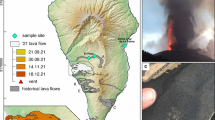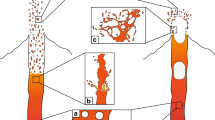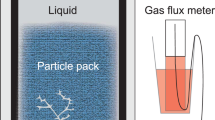Abstract
We report experiments on the flow of two fluids of contrasting viscosity through a pipe in which low-viscosity fluid occupies the center of the pipe. The volume flux of the low-viscosity fluid in the pipe increased during an experiment but did not reach 100% in most cases. The transition from high- to low-viscosity-dominated outflow involved a drop in pressure gradient and an increase in flow rate due to reduced viscous resistance in the pipe. Initially, the central flow was thin and parallel-sided, but as its diameter increased the flow became unstable. A sequence of instabilities was observed during the course of each experiment, both in time and as a function of height in the pipe. In the most commonly observed instability the central flow adopted a helical geometry. The transition from parallel-sided to unstable flow first appeared at the top of the pipe and propagated downwards against the flow. Axisymmetric instabilities originating at the pipe entrance were also observed. All forms of instability exhibited entrainment of viscous fluid into the faster moving central flow. Entrainment was extensive early in the existence of the central flow, but later on the volume flux of lower-viscosity fluid in the central flow rose more rapidly than the rate of entrainment and the proportion of lower-viscosity fluid increased with time. These compositional changes determined the viscosity of the central flow which was found to control its diameter and velocity. In banded pumice deposits, silicic pumice without mafic component is commonly erupted alongside banded pumice blocks. We infer that banded pumice may correspond to the central flow in our experiments, i. e., that viscous magma has been incorporated into less viscous melt, and that pure acid pumice is derived from the outer flow. Changes in eruption style may be caused by variations in pressure gradient and flow rate due to changes in the viscosity of the melt in the conduit. Varied mafic/silicic proportions and degree of mixing in magmatic associations are controlled by the bulk volume erupted, discharge rate, initial temperature difference and aspect ratio of the conduit.
Similar content being viewed by others
References
Bacon CR (1986) Magmatic inclusions in silicic and intermediate volcanic rocks. J Geophys Res 91: 6091–6112
Bacon CR, Metz J (1984) Magmatic inclusions in rhyolite, contaminated basalts, and compositional zonation beneath the Coso volcanic field, California. Contrib Mineral Petrol 85: 346–365
Blake DH, Elwell RWD, Gibson IL, Skelhorn RR, Walker GPL (1965) Some relationships resulting from the intimate association of acid and basic magmas. Quart J Geol Soc London 121: 31–49
Blake S (1981) Eruptions from zoned magma chambers. J Geol London 138: 281–287
Blake S (1984) Magma mixing and hybridization processes at the alkalic, silicic, Torfajökull central volcano triggered by tholeiitic Veidivötn fissuring, South Iceland. J Volcanol Geotherm Res 22: 1–31
Blake S, Campbell IH (1986) The dynamics of magma-mixing during flow in volcanic conduits. Contrib Mineral Petrol 94: 72–81
Blake S, Ivey GN (1986) Magma-mixing and the dynamics of withdrawal from stratified reservoirs. J Volcanol Geotherm Res 27: 153–178
Bottinga Y, Richet P, Weill DF (1983) Calculation of the density and thermal expansion coefficient of silicate liquids. Bull Mineral 106: 129–138
Boyd FR (1961) Welded tuffs and flows in the Rhyolite Plateau of Yellowstone Park, Wyoming. Geol Soc Am Bull 72: 387–426
Druitt TH (1985) Vent evolution and lag breccia formation during the Cape Riva eruption of Santorini, Greece. J Geol 93: 439–454
Druitt TH, Sparks RSJ (1984) On the formation of calderas during ignimbrite eruptions. Nature 310: 679–681
Eichelberger JC (1980) Vesiculation of mafic magma during replenishment of silicic magma reservoirs. Nature 288: 446–450
Hickox CE (1971) Instability due to viscosity and density stratification in axisymmetric pipe flow. The Physics of Fluids 14: 251–262
Hildreth W (1981) Gradients in silicic magma chambers: Implications for lithospheric magmatism. J Geophys Res 86: 10153–10192
Hildreth W (1983) The compositionally zoned eruption of 1912 in the Valley of Ten Thousand Smokes, Katmai National Park, Alaska. J Volcanol Geotherm Res 18: 1–56
Huppert HE, Sparks RSJ, Turner JS (1982) Effects of volatiles on mixing in calc-alkaline magma systems. Nature 297: 554–557
Huppert HE, Shepherd JB, Sigurdsson H, Sparks RSJ (1982) On lava dome growth, with application to the 1979 lava extrusion of the Soufriere of St. Vincent. J Volcanol Geotherm Res 14: 199–222
Jorgensen KA (1980) The Thörsmörk ignimbrite: An unusual comenditic pyroclastic flow in southern Iceland. J Volcanol Geotherm Res 8: 7–22
Kouchi A, Sunagawa I (1983) Mixing basaltic and dacitic magmas by forced convection. Nature 304: 527–528
Kouchi A, Sunagawa I (1985) A model for mixing basaltic and dacitic magmas as deduced from experimental data. Contrib Mineral Petrol 89: 17–23
Koyaguchi T (1985) Magma mixing in a conduit. J Volcanol Geotherm Res 25: 365–369
Liter L, Pescatore T, Booth B, Walker GPL (1973) Two Plinian pumice-fall deposits from Somma-Vesuvius, Italy. Geol Soc Am Bull 84: 759–772
Macdonald GA, Katsura T (1965) Eruption of Lassen Peak, Cascade Range, California, in 1915: Example of mixed magmas. Geol Soc Am Bull 76: 475–482
McGarvie DW (1984) Torfajökull: A volcano dominated by magma mixing. Geology 12: 685–688
Merzkirch W (1974) Flow visualization. Academic Press, New York, London, pp 250
Moore JG, Lipman PW, Swanson DA, Alpha TR (1981) Growth of lava domes in the crater, June 1980–January 1981. In: PW Lipman, DR Mullineaux (eds) The 1980 eruptions of Mount St Helens, Washington. US Geol Surv Prof Pap 1250: 541–547
Schmincke HU (1969) Petrologie der phonolithischen bis rhyolithischen Vulkanite auf Gran Canaria, Kanarische Inseln. Habilitationsschrift, Universität Heidelberg, pp 1–151
Shaw HR (1972) Viscosities of magmatic silicate liquids: An empirical method of prediction. Am J Sci 272: 870–893
Sigurdsson H, Sparks RSJ (1981) Petrology of rhyolitic and mixed magma ejecta from the 1875 eruption of Askja, Iceland. J Petrol 22: 41–84
Sparks RSJ, Marshall LA (1986) Thermal and mechanical constraints on mixing between mafic and silicic magmas. J Volcanol Geotherm Res 29: 99–124
Sparks RSJ, Sigurdsson H, Wilson L (1977) Magma mixing: A mechanism for triggering acid explosive eruptions. Nature 267: 315–318
Spera FJ, Yuen DA, Greer JC, Sewell G (1986) Dynamics of magma withdrawal from stratified magma chambers. Geology 14: 723–726
Thompson RA, Dungan MA (1985) The petrology and geochemistry of the Handkerchief Mesa mixed magma complex, San Juan Mountains, Colorado. J Volcanol Geotherm Res 26: 251–274
Vogel TA, Wilbrand JT (1978) Coexisting acidic and basic melts: Geochemistry of a composite dike. J Geol 86: 353–371
Walker GPL (1981) Plinian eruptions and their products. Bull Volcanol 44: 223–240
Walker GPL, Skelhorn RR (1966) Some associations of acid and basic igneous rocks. Earth-Sci Rev 2: 93–109
Wiebe RA (1973) Relations between coexisting basaltic and granitic magmas in a composite dike. Am J Sci 273: 130–151
Wilson L, Sparks RSJ, Walker GPL (1980) Explosive volcanic eruptions, IV: The control of magma properties and conduit geometry on eruption column behaviour. Geophys J R Astron Soc 63: 117–148
Wolff JA, Storey M (1984) Zoning in highly alkaline magma bodies. Geol Mag 121: 563–575
Author information
Authors and Affiliations
Rights and permissions
About this article
Cite this article
Freundt, A., Tait, S.R. The entrainment of high-viscosity magma into low-viscosity magma in eruption conduits. Bull Volcanol 48, 325–339 (1986). https://doi.org/10.1007/BF01074464
Received:
Accepted:
Issue Date:
DOI: https://doi.org/10.1007/BF01074464




